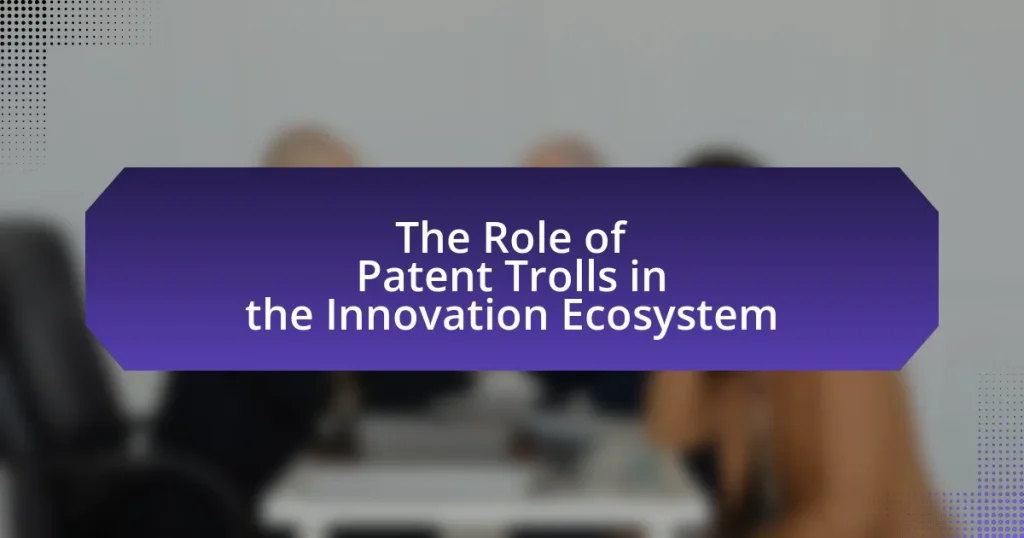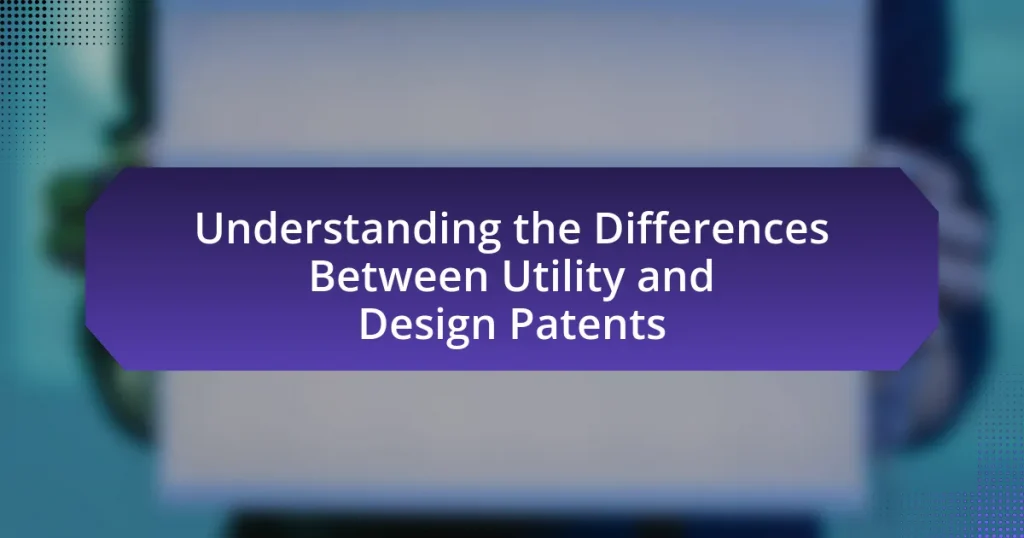The article focuses on the process of patent opposition, which allows third parties to challenge the validity of granted patents within a specified timeframe. It outlines the key stages involved, including the filing of opposition, examination, and decision-making phases, as well as the roles of the patent holder, opposer, and patent office. The article emphasizes the importance of patent opposition in maintaining the integrity of the patent system by ensuring that only valid patents are enforced, and discusses the grounds for opposition, potential outcomes, and best practices for effective preparation. Additionally, it highlights the impact of patent opposition on innovation and competition, providing a comprehensive overview of the procedural steps and legal bases involved in challenging a patent.
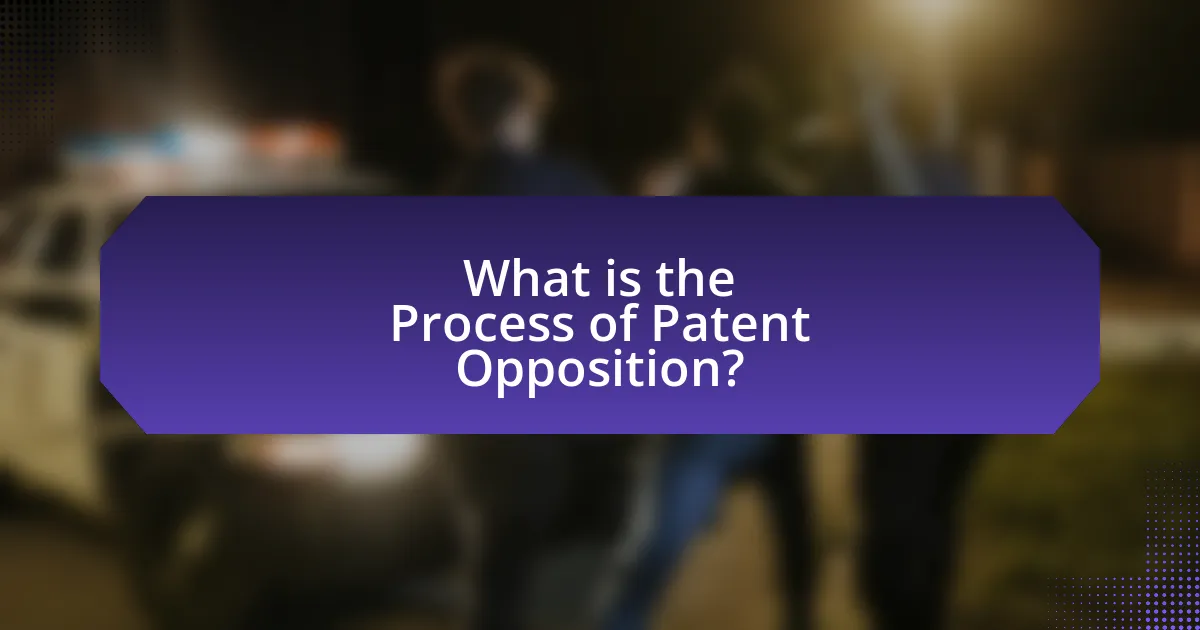
What is the Process of Patent Opposition?
The process of patent opposition involves challenging the validity of a granted patent within a specified timeframe, typically initiated by a third party. This process allows individuals or organizations to present evidence and arguments against the patent’s claims, often focusing on issues such as prior art or lack of novelty. In many jurisdictions, the opposition must be filed within a certain period after the patent is published, usually ranging from three to six months. The patent office then reviews the opposition, allowing both the patent holder and the opponent to submit their arguments and evidence. A decision is made based on the merits of the case, which can result in the patent being upheld, amended, or revoked. This process is crucial for maintaining the integrity of the patent system by ensuring that only valid patents are enforced.
How does the Patent Opposition process work?
The Patent Opposition process allows third parties to challenge the validity of a granted patent within a specified period, typically nine months from the patent’s publication. During this process, the opposing party submits a notice of opposition, outlining the grounds for the challenge, which may include lack of novelty or inventive step. The patent holder then has the opportunity to respond to the opposition. Following this, a formal examination occurs, where both parties may present evidence and arguments. The patent office reviews the submissions and ultimately decides whether to uphold or revoke the patent. This process is crucial for ensuring that only valid patents remain enforceable, thereby maintaining the integrity of the patent system.
What are the key stages involved in Patent Opposition?
The key stages involved in Patent Opposition include the filing of the opposition, examination of the opposition, and the decision phase. Initially, the opposing party submits a formal notice of opposition to the relevant patent office, outlining the grounds for opposition. Following this, the patent office examines the opposition, which may involve reviewing evidence and arguments from both the patent holder and the opponent. Finally, the patent office issues a decision regarding the validity of the patent in question, which can result in the patent being upheld, amended, or revoked. These stages ensure a structured process for resolving disputes over patent rights.
What roles do different parties play in the Patent Opposition process?
In the Patent Opposition process, the primary parties involved are the patent holder, the opposer, and the patent office. The patent holder defends the validity of their patent against challenges, providing evidence and arguments to support its originality and utility. The opposer, typically a third party, submits formal objections to the patent, arguing that it should not have been granted due to reasons such as lack of novelty or obviousness. The patent office acts as an impartial adjudicator, reviewing the evidence and arguments presented by both the patent holder and the opposer to make a determination on the patent’s validity. This process ensures that patents meet the required legal standards before being upheld.
Why is Patent Opposition important?
Patent opposition is important because it provides a mechanism for challenging the validity of a patent before it is granted, thereby ensuring that only truly innovative and non-obvious inventions receive patent protection. This process helps maintain the integrity of the patent system by preventing the issuance of patents that could hinder competition and innovation. For instance, the European Patent Office reported that in 2020, approximately 30% of patents opposed were revoked or amended, demonstrating the effectiveness of opposition in filtering out weak patents.
What are the potential outcomes of a Patent Opposition?
The potential outcomes of a Patent Opposition include the revocation of the patent, maintenance of the patent, or amendments to the patent claims. In a successful opposition, the opposing party can demonstrate that the patent lacks novelty or inventive step, leading to its revocation. Conversely, if the patent holder successfully defends the opposition, the patent remains valid. Additionally, during the opposition process, the patent claims may be amended to address the concerns raised, which can result in a narrower scope of protection. These outcomes are significant as they directly impact the enforceability and commercial viability of the patent in question.
How does Patent Opposition impact innovation and competition?
Patent opposition enhances innovation and competition by allowing third parties to challenge the validity of granted patents, thereby preventing the monopolization of ideas. This process encourages a more rigorous examination of patent claims, which can lead to the rejection of overly broad or unjustified patents. For instance, a study by the European Patent Office found that opposition proceedings resulted in the revocation or amendment of about 30% of contested patents, fostering a more competitive environment where new entrants can innovate without the fear of infringement. Consequently, patent opposition serves as a mechanism to balance the interests of patent holders and the public, ultimately driving technological advancement and market competition.
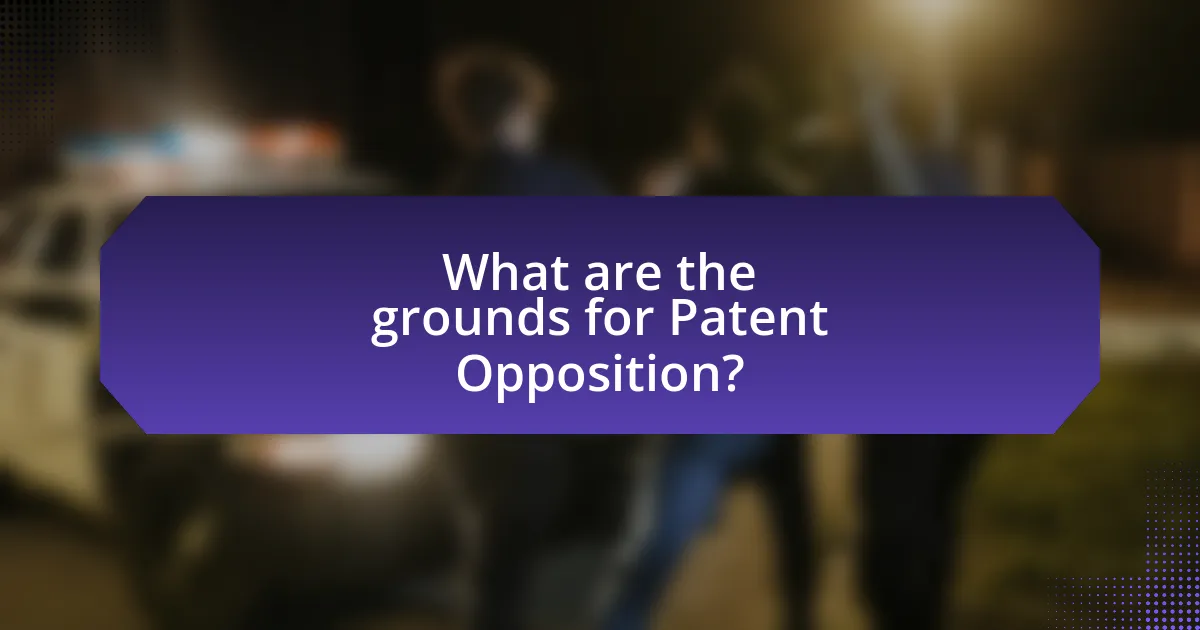
What are the grounds for Patent Opposition?
The grounds for Patent Opposition include lack of novelty, lack of inventive step, and non-patentable subject matter. Lack of novelty refers to the invention not being new or previously disclosed in prior art. Lack of inventive step indicates that the invention is obvious to someone skilled in the field based on existing knowledge. Non-patentable subject matter encompasses inventions that do not meet the criteria for patentability, such as abstract ideas or natural phenomena. These grounds are established under patent laws and regulations, which aim to ensure that only deserving inventions receive patent protection.
What legal bases can be used for opposing a patent?
Legal bases for opposing a patent include lack of novelty, lack of inventive step, and insufficient disclosure. Lack of novelty occurs when the claimed invention has been previously disclosed in prior art, making it unpatentable under patent laws. Lack of inventive step refers to the situation where the invention is obvious to a person skilled in the art, which also disqualifies it from patent protection. Insufficient disclosure happens when the patent application does not provide enough information for a person skilled in the art to reproduce the invention, violating patent requirements. These bases are grounded in patent law principles that ensure only deserving inventions receive protection.
How do novelty and non-obviousness relate to Patent Opposition?
Novelty and non-obviousness are critical criteria in patent opposition, as they determine whether a patent should be granted or upheld. Novelty requires that the invention is new and has not been disclosed in prior art, while non-obviousness assesses whether the invention is sufficiently different from existing knowledge that it would not be obvious to a person skilled in the field. In patent opposition proceedings, challengers often argue that a patent lacks novelty or is obvious based on prior art, which can lead to the revocation of the patent if the claims are found to be unpatentable. For instance, the European Patent Convention stipulates that a patent must meet both criteria to be valid, and failure to do so can result in successful opposition.
What role does prior art play in the grounds for opposition?
Prior art serves as a critical basis for grounds of opposition in patent disputes, as it can demonstrate that an invention is not novel or lacks inventive step. When a party opposes a patent, they can present prior art—such as existing patents, publications, or public knowledge—to argue that the claimed invention was already known before the patent application was filed. This is essential because patent law requires that an invention must be new and non-obvious to qualify for patent protection. The presence of prior art can invalidate a patent claim if it shows that the invention does not meet these criteria, thereby influencing the outcome of the opposition process.
What evidence is required for a successful Patent Opposition?
A successful Patent Opposition requires evidence that demonstrates the patent’s invalidity, such as prior art, lack of novelty, or obviousness. Prior art includes any public disclosures, publications, or patents that existed before the filing date of the contested patent, which can show that the invention was not new. Evidence of lack of novelty can be established by presenting documents or materials that describe the same invention, while obviousness can be supported by showing that the invention is an obvious extension of existing knowledge to a person skilled in the relevant field. These forms of evidence are critical in persuading the patent office or court to revoke the patent in question.
How can opponents gather and present evidence effectively?
Opponents can gather and present evidence effectively by systematically collecting relevant documentation, expert testimonies, and prior art that supports their claims against a patent. This process involves conducting thorough research to identify existing patents, scientific literature, and public disclosures that may invalidate the patent in question. For instance, utilizing databases such as Google Patents or the United States Patent and Trademark Office (USPTO) can yield critical information on similar inventions. Additionally, presenting evidence in a clear and organized manner, such as through charts or timelines, enhances comprehension and strengthens the argument. Effective presentation also includes citing specific legal precedents or case studies that demonstrate the relevance of the evidence, thereby reinforcing the validity of the opposition.
What types of documentation are crucial in the opposition process?
The types of documentation crucial in the opposition process include prior art references, legal arguments, evidence of use, and expert declarations. Prior art references serve to demonstrate that the patent in question lacks novelty or non-obviousness, which are essential criteria for patentability. Legal arguments outline the basis for the opposition, often citing relevant laws and regulations. Evidence of use can include product samples or sales data that show the existence of prior art in the market. Expert declarations provide authoritative opinions that support the claims made in the opposition, reinforcing the argument against the patent’s validity. These documents collectively form the foundation for a robust opposition case, ensuring that all necessary aspects are addressed to challenge the patent effectively.
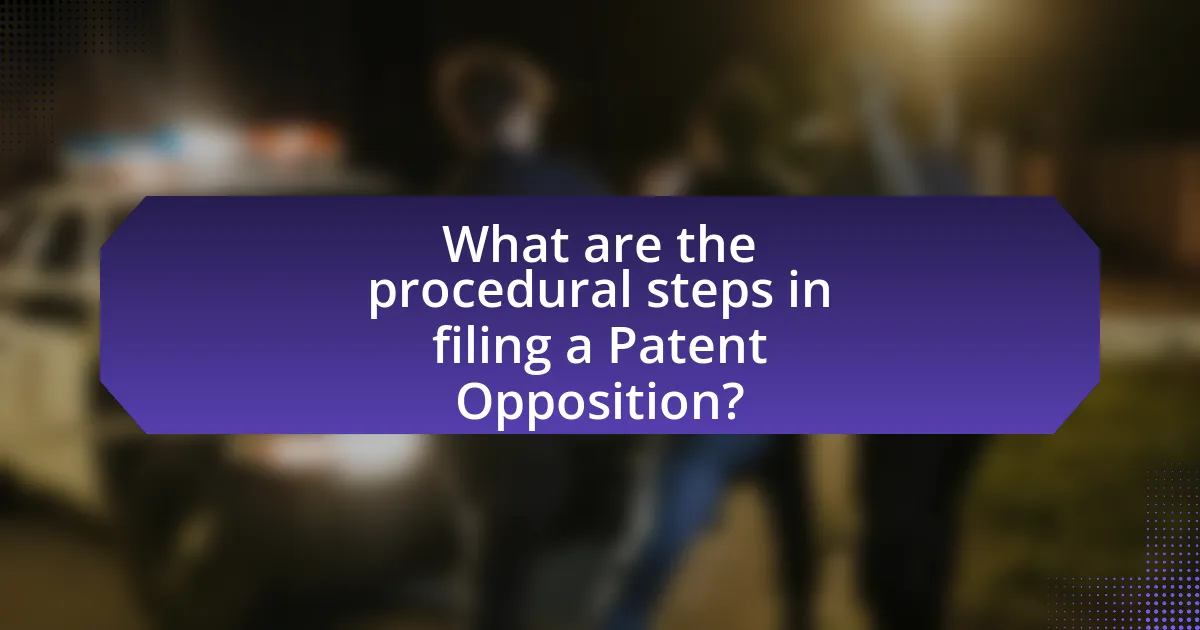
What are the procedural steps in filing a Patent Opposition?
The procedural steps in filing a Patent Opposition include the following: First, the opposing party must file a notice of opposition with the relevant patent office, typically within a specified time frame after the patent is published. Next, the opposing party submits a statement of grounds for opposition, detailing the reasons for opposing the patent, which may include lack of novelty or inventive step. Following this, the patent holder is given an opportunity to respond to the opposition. After the responses are exchanged, the patent office may conduct hearings or request additional evidence from both parties. Finally, the patent office issues a decision regarding the opposition, which can uphold, amend, or revoke the patent. These steps are governed by specific rules and timelines set forth by the patent office, ensuring a structured process for resolving disputes over patent validity.
How do you initiate a Patent Opposition?
To initiate a Patent Opposition, a party must file a notice of opposition with the relevant patent office within the specified time frame, typically within nine months of the patent’s publication. This notice should include the grounds for opposition, such as lack of novelty or inventive step, and must be supported by evidence. The process is governed by specific rules set forth by the patent office, which outline the necessary documentation and procedures to follow. For instance, the European Patent Office requires the submission of a written statement detailing the reasons for opposition, along with any supporting documents.
What forms and fees are involved in filing an opposition?
To file an opposition, the primary form required is the Notice of Opposition, which must be submitted to the relevant patent office. The fees associated with filing an opposition vary by jurisdiction; for example, in the United States, the fee for filing a Notice of Opposition with the United States Patent and Trademark Office is typically around $300. In the European Union, the fee for filing an opposition with the European Patent Office is approximately €800. These fees are subject to change, so it is essential to verify the current rates on the respective patent office’s website.
What timelines should be considered during the opposition process?
During the opposition process, key timelines include the filing deadline for opposition, which typically occurs within nine months of the patent grant, and the response period for the patent owner, usually set at two months after the opposition is filed. Additionally, the opposition proceedings may take several months to years, depending on the complexity of the case and the jurisdiction. These timelines are critical as they dictate the pace and structure of the opposition process, ensuring that all parties adhere to procedural requirements.
What happens during the hearing of a Patent Opposition?
During the hearing of a Patent Opposition, the parties involved present their arguments and evidence regarding the validity of the patent in question. The opposition typically includes the opponent, who challenges the patent, and the patent holder, who defends it. Each party is allowed to submit written statements and may also provide oral arguments before a panel or a designated authority. The hearing allows for cross-examination of witnesses and the introduction of expert testimony. The outcome of the hearing will determine whether the patent remains valid or is revoked, based on the evidence and arguments presented.
How is the hearing structured and what can be expected?
The hearing in a patent opposition process is structured to allow both parties to present their arguments and evidence regarding the validity of the patent in question. Typically, the hearing begins with the opposition presenting its case, followed by the patent holder’s defense, and concludes with rebuttals from both sides. Each party is usually allotted a specific amount of time to present their arguments, supported by relevant documentation and witness testimonies. The structure aims to ensure a fair and balanced examination of the issues at hand, allowing the adjudicating body to make an informed decision based on the merits of the case.
What arguments are typically presented by both sides?
In the context of patent opposition, the arguments typically presented by both sides include the challenger asserting that the patent lacks novelty or non-obviousness, while the patent holder defends the validity of the patent by demonstrating its unique contributions and compliance with patent laws. Challengers often cite prior art to support claims of invalidity, emphasizing that the invention was already known or obvious to someone skilled in the field. Conversely, patent holders may present evidence of the invention’s practical applications and commercial success, reinforcing its significance and originality. These arguments are critical in determining the outcome of the opposition process, as they directly address the legal standards for patentability established by patent law.
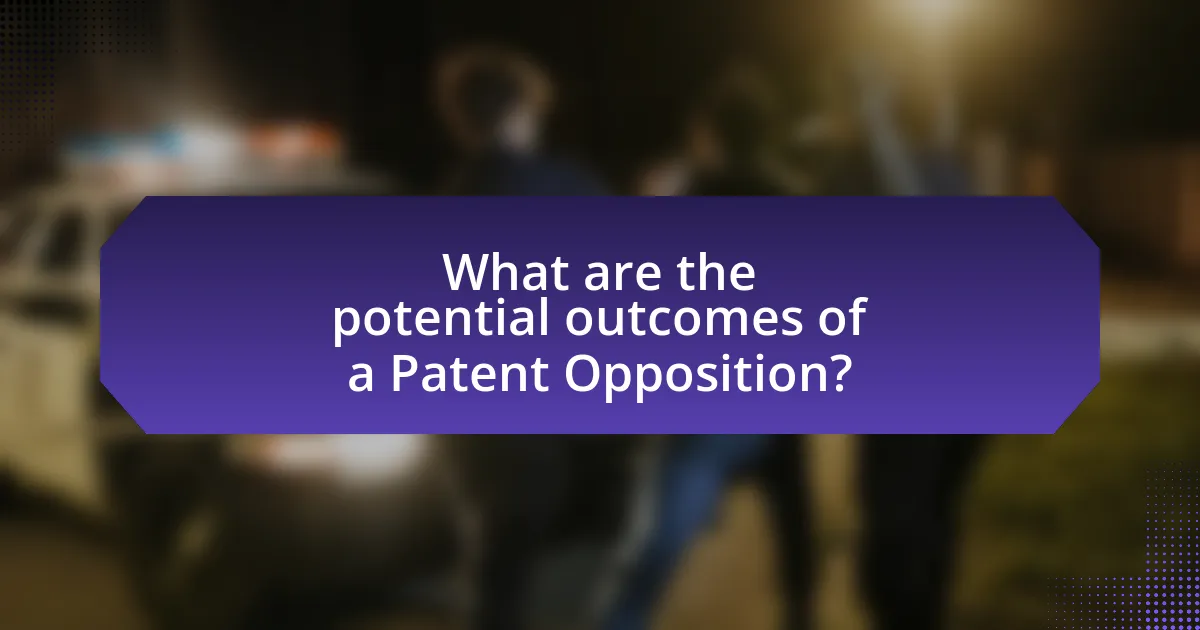
What are the potential outcomes of a Patent Opposition?
The potential outcomes of a Patent Opposition include the revocation of the patent, maintenance of the patent, or amendments to the patent claims. In a successful opposition, the opposing party can demonstrate that the patent lacks novelty or inventive step, leading to its revocation. Conversely, if the patent holder successfully defends the opposition, the patent remains valid. Additionally, during the opposition process, the patent claims may be amended to address the concerns raised, which can result in a narrower scope of protection. These outcomes are significant as they directly impact the rights of the patent holder and the opposing party, influencing market competition and innovation.
What decisions can be made following a Patent Opposition?
Following a Patent Opposition, several decisions can be made, including the rejection of the patent, the maintenance of the patent, or amendments to the patent claims. The patent office evaluates the opposition and can decide to revoke the patent if the opposition is upheld, which occurs when the opposing party successfully demonstrates that the patent does not meet the necessary criteria for patentability, such as novelty or non-obviousness. Alternatively, if the patent is deemed valid, it may be maintained as is or modified based on the feedback received during the opposition process. This decision-making process is guided by legal standards and precedents established in patent law, ensuring that the outcomes are consistent with established criteria for patent validity.
What are the implications of a successful opposition?
A successful opposition in the context of patent law can lead to the revocation or amendment of a patent, significantly impacting the patent holder’s rights. This outcome can result in the loss of exclusive market control for the patent holder, potentially diminishing their competitive advantage and revenue. Furthermore, a successful opposition can set a precedent that may encourage further challenges against similar patents, thereby influencing the overall patent landscape. For instance, in the case of the European Patent Office, successful oppositions have led to the cancellation of patents that were deemed not to meet the required standards of novelty and inventive step, as seen in the opposition against the patent for the drug “Eli Lilly’s Alimta,” which was revoked due to lack of novelty.
What options are available if the opposition is unsuccessful?
If the opposition is unsuccessful, the primary option available is to appeal the decision to a higher authority, such as a patent office or court. This process allows the opposing party to challenge the ruling based on legal grounds or procedural errors. For instance, in the United States, an unsuccessful opposition can be appealed to the Patent Trial and Appeal Board (PTAB) or through judicial review in federal court. Additionally, the opposing party may consider negotiating a settlement or licensing agreement with the patent holder to mitigate potential infringement risks. These options are supported by established legal frameworks that govern patent disputes, ensuring that parties have avenues to seek redress or alternative resolutions.
What best practices should be followed in Patent Opposition?
The best practices in Patent Opposition include conducting thorough prior art searches, preparing a well-structured opposition document, and adhering to deadlines. Thorough prior art searches ensure that relevant information is identified, which strengthens the case against the patent. A well-structured opposition document clearly outlines the grounds for opposition, such as lack of novelty or inventive step, and presents evidence effectively. Adhering to deadlines is crucial, as missing them can result in the loss of the opportunity to oppose the patent. These practices are supported by the fact that successful oppositions often rely on comprehensive evidence and timely submissions, as demonstrated in numerous cases where oppositions led to the revocation of patents based on solid prior art.
How can one prepare effectively for a Patent Opposition?
To prepare effectively for a Patent Opposition, one must conduct thorough prior art searches to identify relevant patents and publications that may challenge the validity of the patent in question. This involves analyzing existing patents, scientific literature, and any public disclosures that relate to the invention. Additionally, gathering expert opinions and preparing a detailed written submission that outlines the grounds for opposition, supported by evidence, is crucial. According to the European Patent Office, a well-structured opposition can significantly increase the chances of success, as it allows for a clear presentation of arguments and supporting documentation.
What common pitfalls should be avoided during the process?
Common pitfalls to avoid during the patent opposition process include failing to conduct thorough prior art searches, which can lead to weak arguments against the patent. Additionally, not adhering to deadlines can result in missed opportunities to present evidence or arguments, ultimately weakening the opposition. Inadequate documentation of claims and evidence can also undermine the case, as clear and organized submissions are crucial for effective communication with patent offices. Lastly, neglecting to understand the legal framework and procedural rules governing the opposition can lead to procedural errors that may jeopardize the opposition’s success.

